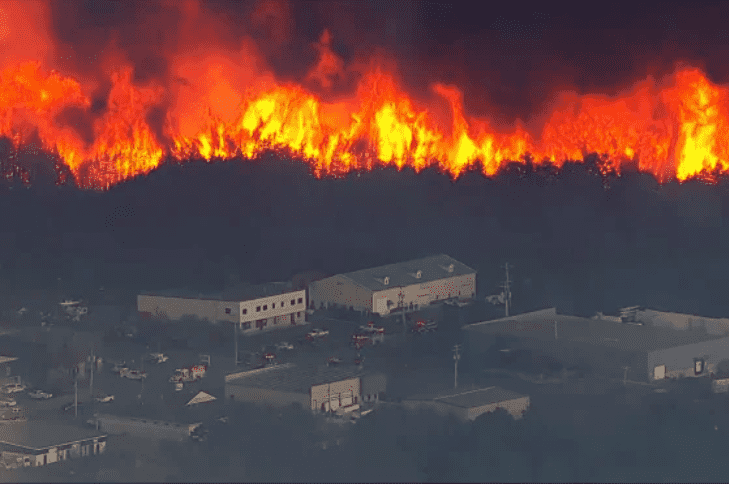Introduction
Jones Road Wildfire April 22, 2025, a rapidly expanding wildfire known as the Jones Road Fire erupted in the Greenwood Forest Wildlife Management Area of Barnegat Township, Ocean County, New Jersey. Within hours, the blaze consumed over 8,500 acres, prompting the evacuation of approximately 3,000 residents and threatening more than 1,300 structures. The fire’s swift progression and the challenges it poses underscore the increasing frequency and intensity of wildfires in regions previously considered low-risk
Rapid Spread and Immediate Impact
The Jones Road Fire ignited around 10 a.m. on April 22. Fueled by dry conditions and strong winds, the fire expanded from 3,200 acres to 8,500 acres within a matter of hours. By late evening, containment efforts had achieved only 10% success. The fire’s rapid growth necessitated immediate action to protect lives and property.
The New Jersey Forest Fire Service reported that the blaze threatened approximately 1,320 structures, including residential homes and industrial facilities. In Lacey Township, three buildings in the industrial zone sustained damage, with one building completely destroyed. Despite the extensive property threats, no injuries have been reported as of the latest updates.  For the more information click on this link
For the more information click on this link
Evacuations and Emergency Response
Mandatory evacuation orders were issued for residents in several communities, including Waretown and parts of Barnegat Township. In Waretown, residents east of the Garden State Parkway and near Route 9 were directed to evacuate. Voluntary evacuations occurred in neighborhoods such as Windward, Mirage, Pheasant Run, Heritage Point North, Brookville, and homes along West Bay Avenue in Barnegat
Emergency shelters were established at Southern Regional High School in Stafford Township and Manchester Township High School in Manchester. These shelters also accommodated pets, Jones Road Wildfire providing a safe haven for both residents and their animals
The Jersey Central Power and Light Company proactively cut electricity to approximately 25,000 customers, primarily in Barnegat Township, Jones Road Wildfire to ensure the safety of firefighting crews. Power restoration was not expected until the following day
Transportation Disruptions
The Jones Road Wildfire forced the closure of significant transportation routes, including a 17-mile stretch of the Garden State Parkway between Exits 63 and 80. Additional road closures included Route 532 (Wells Mills Road) between Route 72 and the Garden State Parkway, Bryant Road between Wells Mills Road and Route 539, and Jones Road between Route 532 and Bryant Road. These closures disrupted travel and posed challenges for evacuation and emergency response efforts
Environmental Conditions and Fire Behavior
The rapid spread of the Jones Road Fire can be attributed to a combination of environmental factors. As of April 2025, nearly 80% of New Jersey was experiencing some level of drought, significantly increasing wildfire risk. The Pine Barrens region, characterized by its dense forests and flammable vegetation, Jones Road Wildfire provided ample fuel for the fire’s expansion. High winds further exacerbated the situation, carrying embers and igniting new fires ahead of the main blaze
Community Impact and Personal Accounts
Residents affected by the wildfire described scenes of chaos and urgency. Debi Schaffer, a Waretown resident, recounted evacuating with her two dogs while her husband stayed behind to care for their 22 chickens. She described the area around her home as “like a war zone,” Jones Road Wildfire with heavy smoke, sirens, and helicopter activity. Despite the proximity of the fire to an alpaca farm, all animals there remained safe, according to a statement from the farm  For the more information click on this link
For the more information click on this link
Ongoing Efforts and Future Outlook
Firefighting crews continue to battle the blaze, employing fire engines, bulldozers, Jones Road Wildfire and ground crews to contain the fire’s spread. A press conference was scheduled for April 23 to provide updates on containment efforts and address community concerns. The cause of the fire remains under investigation.
This wildfire follows another recent major fire in the region, marking a troubling pattern of wildfire activity in New Jersey. As climate change contributes to drier conditions and increased fire risk, Jones Road Wildfire communities in traditionally low-risk areas must adapt to the growing threat of wildfires.
Conclusion
The Jones Road Wildfire e serves as a stark reminder of the evolving nature of wildfire threats in the United States. As environmental conditions shift, regions like New Jersey’s Pine Barrens are becoming more susceptible to large-scale fires. Proactive measures, community preparedness, and robust emergency response systems are essential to mitigate the impact of such events and protect lives and property. ALSO READ:-Yemen’s Houthi Rebels Fire Missile Targeting Northern Israel, Rare Target for Group 2025





